ASUS PA246Q 24" ProArt Monitor: No Adjustments Needed?
by Chris Heinonen on July 2, 2012 1:30 PM ESTASUS PA246Q - Color Quality
ASUS promises a dE < 5 out of the box with their sRGB and AdobeRGB modes, but do they deliver? Well, yes and no. The problem with this promise is that you have to decide how you are going to measure dE for the display. Do we just measure the dE for white, or grayscale, or grayscale plus the primary colors? Or should we measure the full Gretag Macbeth color checker chart and expect a dE below 5 there? Also, should we use dE 1976, 1994, 2000, or something else? Since none of these are specified, I am unsure how to judge ASUS, other than against other monitors with our standard GMB testing.
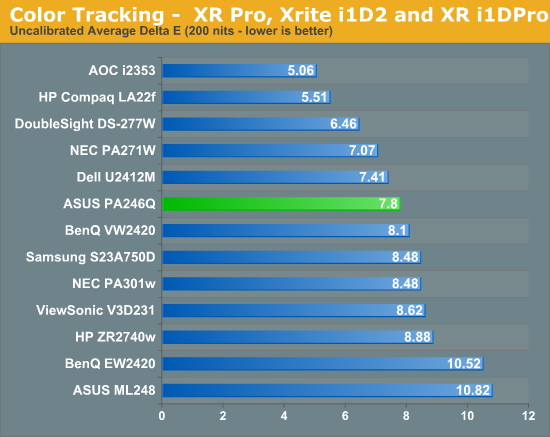
Out of the box in sRGB mode we see that performance isn’t any better or worse than other displays for the most part. However the grayscale is overall very good, and the primary colors are decent for the most part with dE values that are relatively low. If I’m judging the <5 claim based on this, the PA246Q might live up to expectations. Once I move into certain shades of blue, however, the dE really gets high, and so using the whole spectrum I can’t say that it manages <5 dE for the sRGB mode. Perhaps they are using a different dE formula than we are, or perhaps they are only claiming that white will be below 5, but using the same standard we apply to other vendors, the PA246Q isn't any better or worse out of the box than the competition.
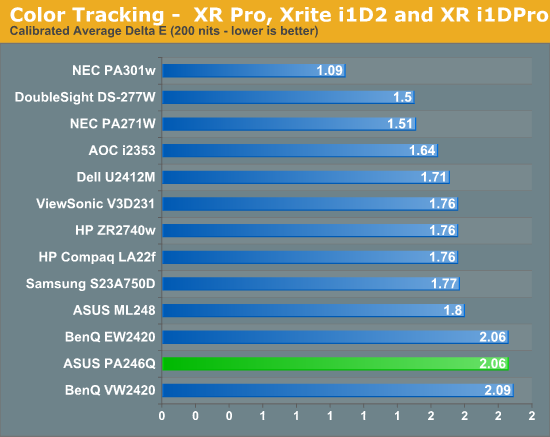
So out of the box the calibration seems fine but not exceptional, but does it calibrate well for those that need it? Overall the calibrated dE of 2.06 looks a little high, but when we examine the graph we see that the grayscale is much higher than any other display in the chart. This is a bit weird, and leads me to wonder how well the two-point grayscale calibrates and is handled internally. I set that for 100% and 30% as those should lead to a fairly accurate grayscale across the gamut, but here it seems to be good at 100% and then really ramp up. If the math is incorrect internally, this could lead to these issues where it has those two points correct, but determining the values for points between them is done incorrectly.
When I broke out the data more, the average dE for the color patches was 2.08 for the ASUS, which is almost equal to the overall value. For other monitors I had data for, the colors were on average 0.25 dE higher than the total dE with grayscale. So it seems that colors are better on the ASUS, but the grayscale is worse. In this case if you are doing photo editing, it might be a better choice than if you are using it for black and white work or even general-purpose work. With spreadsheets and word processing, you don’t notice a tint since the white is very good overall, but dark shadows can be off. So overall the performance of the ASUS PA246Q here was good for color and fairly poor for grayscale, which is different than almost any other display we have seen.

With 100 nits, the grayscale was much better and so the better colors led to a dE that was lower than with 200 nits. Because of this the ASUS seems to be a better performer for print work than for brighter rooms, but really the main area it fails is for black and white photo editing with a brighter screen.
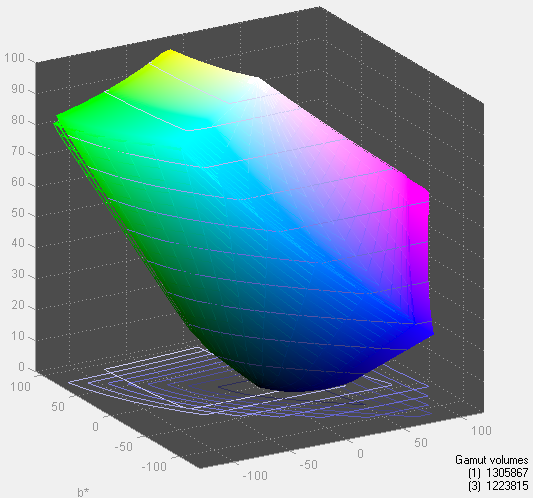
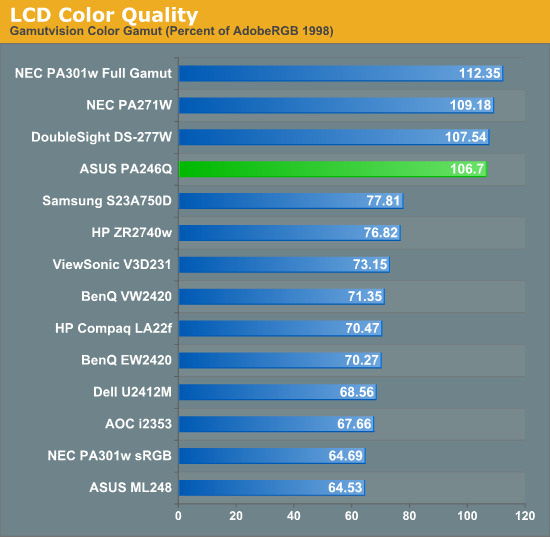
ASUS says they can do the full AdobeRGB gamut on this display and they aren’t lying. With almost 107% coverage it will work well for photographers and other professionals that need the larger gamut.


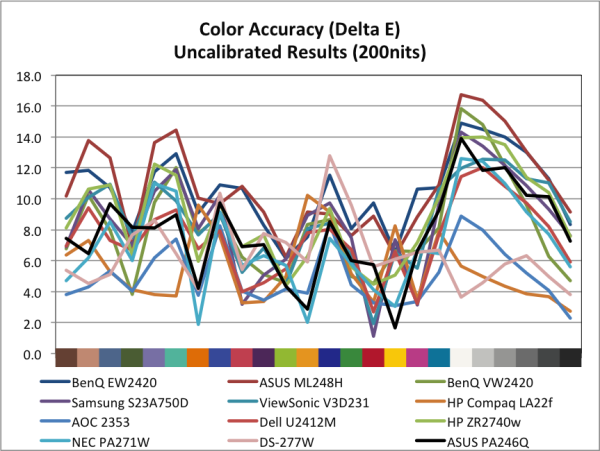
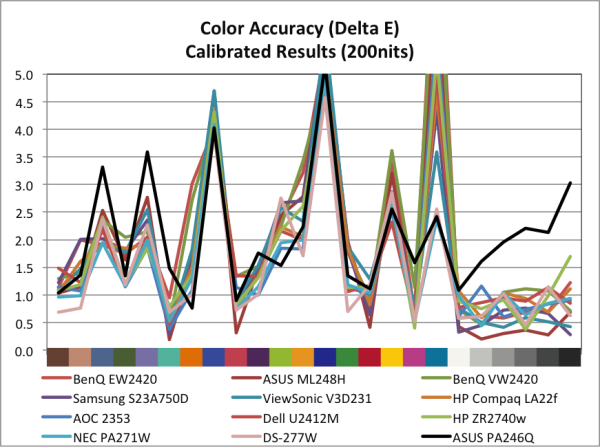









52 Comments
View All Comments
Conficio - Monday, July 2, 2012 - link
just saying!Samus - Tuesday, July 3, 2012 - link
Heh, yeah I agree. One of the reasons I still have a 5 year old NEC is because everything else 24" <$300 is 1920x1080.I need that extra screen real-estate, 120 pixels is an entire row of icons.
kkwst2 - Tuesday, July 3, 2012 - link
You can find the Dell U2412M for less than $300. It is e-IPS, which has compromises but is pretty decent.synaesthetic - Tuesday, July 3, 2012 - link
I use the U2412M and I love it, despite the compromises one must take for eIPS--mind you, I'm not a photographer and I actually play a lot of games, but the input lag is low and it doesn't ever feel "slow." The viewing angles are fantastic, great for when folks cluster around the PC to watch videos. :)Kel Ghu - Saturday, July 7, 2012 - link
Agreed. I'm also mainly a hardcore gamer, but I do a little photo editing too. And you just can't beat the U2412M for the price. With a little calibration, it's really that good. It's not as good as a "real" IPS nor a TN panel. But it retains like 80% of the qualities of both systems!aranyagag - Tuesday, December 11, 2012 - link
+1 for 16:10 --voted with my walletTheCrackLing - Monday, July 2, 2012 - link
You have the min/max backwards for some of the monitors in the graphs.BenQ VW2420
Asus PA246Q
NEC PA271W
NEC PA301W
DoubleSight DS-277W
Are all backwards, and because of this it's causing the sorting on the graph to be a bit off.
JarredWalton - Monday, July 2, 2012 - link
Fixed. Probably just an error in the data in Chris' spreadsheet.rahvin - Friday, July 6, 2012 - link
Jared, can you weigh thing without the stand attached. Might seem a strange request but I use a 2 monitor arm that uses VESA mounts but the system has a weight and size limit. I purchased 22 inch originally to stay under the weight limit (and I'm looking for a better monitor for the main monitor) but ASUS doesn't seem to care to tell anyone what the monitor weighs without the stand as I've looked everywhere.goinginstyle - Monday, July 2, 2012 - link
You guys know this has been replaced by the PA248Q at a much lower price of $339.